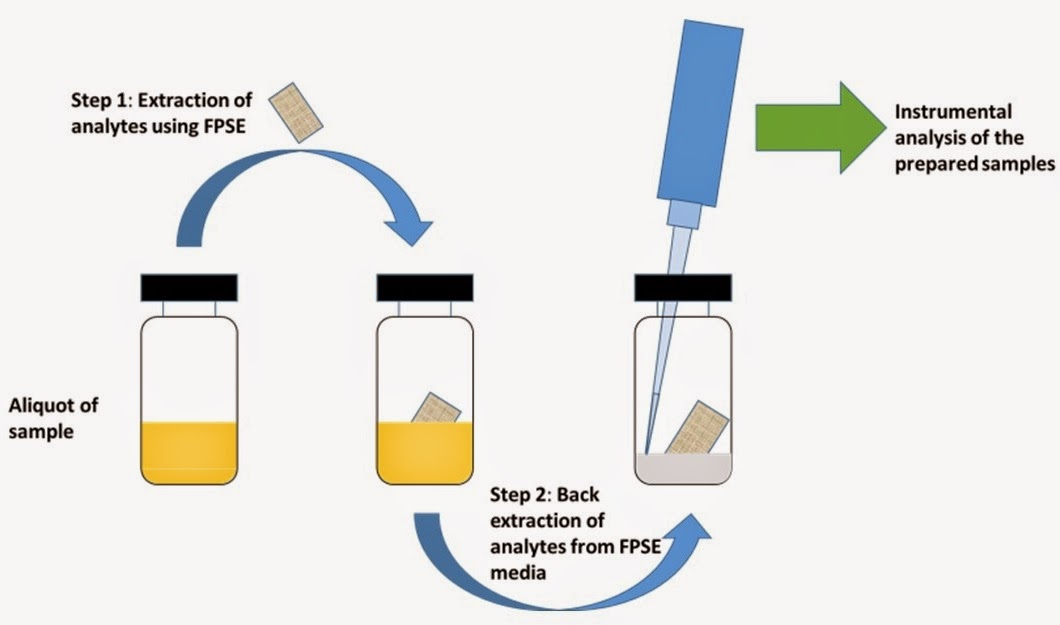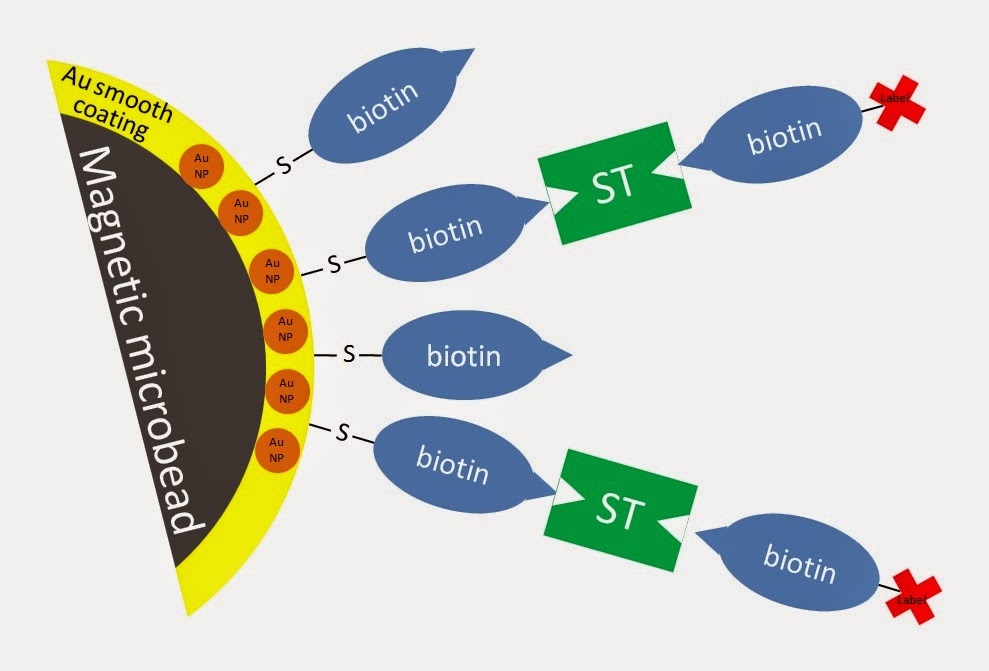Rotating Disk Sorptive Extraction
by Prof. Dr. Pablo Richter, Department
of Inorganic and Analytical Chemistry, Faculty of Chemical and Pharmaceutical
Sciences, University of Chile.
The modern trends in
analytical chemistry promote efficiency and green technology in sample
preparation. In this context, our research team developed a new technique in
2009 that is capable of extracting pollutants from liquid samples on a rotating
PTFE disk with one surface coated with an extraction phase [1]. The disk has
embedded a miniature magnetic rod, which allows rotation. We have termed this
procedure rotating-disk sorptive extraction (RDSE).
RDSE is currently
available in two configurations. In the classic version (Figure 1), the extraction
phase is a polymeric film adhered to one side of the PTFE disk (configuration
1). In this configuration, polydimethylsiloxane (PDMS), nylon and octadecyl
(C18) have been used as the sorptive material for the extraction of
low-polarity analytes (Log Kow between 3 and 7) [1-12]. However, for more polar
analytes, quantitative recoveries are not achievable with short extraction
times [2].
The second RDSE version
(configuration 2) [13,14] consists of a disk that contains a cavity that is
loaded with an extraction phase and is then covered with a glass-fiber filter
and sealed with a ring of Teflon (Figure 2). This configuration was
successfully employed for the extraction of florfenicol from porcine plasma [14]
and non steroidal anti-inflammatory drugs (NAIDs) in water using Oasis® HLB as
the sorptive material [13]. The use of the disk with cavity allows the
incorporation of commercial or synthesized SPE extraction phases and maximizes
the sorptive capacity by recirculating the sample through the phase using the
rotating disk technology. Molecularly imprinted polymers (commercial or
synthesized in the laboratory) can also be employed as an alternative to HLB,
thereby enabling improved selectivity, and extraction efficiency.
 |
| Figure 2. Rotating disk with a cavity in which an extraction phase is loaded and is then covered with a glass-fiber filter and sealed with a ring of PTFE. |
From a theoretical
point of view, thermodynamic and kinetic parameters are critical factors in the
efficiency of a given microextraction technique. Both kinds of parameters must
be considered because the main objective of these techniques is to achieve efficient
analyte extraction in a reasonable time [15, 16]. Previous studies of the partitioning of
organic compounds between PDMS and water suggested that the overall mass
transfer of low-polarity organic compounds is not limited by internal diffusion
in the PDMS but rather by diffusion in the aqueous boundary layer [7, 17-19].
Thus, the rate-determining step in the equilibrium extraction time is the
diffusion of the analytes through the water boundary layer. Efficient stirring
of the sample contacting the sorptive phase is necessary to achieve the
partition equilibrium as rapidly as possible, because the thickness of the
boundary layer is reduced when the rotating velocity is increased [15,20]. Further,
initial extraction rate is roughly proportional to the surface area of the
extraction phase [15], consequently the equilibration time can be greatly
shortened when the extraction device provide a larger surface area/volume ratio.
The extraction device
used in RDSE exhibits an extraction phase with a high surface-area-to-volume
ratio and can be stirred at much higher velocities than the stir bar used in
SBSE without damaging the phase, because the extraction phase is only in
contact with the liquid sample. Thus, higher rotating velocities facilitate
analyte mass transfer to the sorptive surface [1,10-13].
These two
configurations of the extraction device provide to RDSE a highly versatility,
since any sorptive material used in both SPE and SBSE could be immobilized on
the rotating disk. In addition, RDSE provides some advantages over SPE,
especially by allowing the recirculation of the sample through the extraction
phase and, thus, maximizing its sorptive capacity (in SPE, the sorption occurs
while the sample passes unidirectionally through the solid support).
Furthermore, in RDSE, the interface is continuously renewed during the
extraction process, which minimizes the involved cleanup steps for complex
samples that are required with SPE.
Other important
characteristics of RDSE are related with the geometry of the extraction device,
which allows an easier automation of the extraction process [8], a direct
spectroscopic measurement in the extraction phase [4-6], and the feasibility of
the use in bioavailability studies [12].
Recently a novel
automatic sorptive microextraction approach combining sequential
injection-based programmable flow with rotating disk sorptive extraction (RDSE)
was proposed for the clean-up and concentration of low polarity organic species
in urine samples [8]. Compared to its batch counterpart [13], the main
advantage of the proposed dynamic method is its improved sample throughput with
sample preparation times decreasing from 90 min to merely 15 min when the
SI-RDSE is used.
Most of the
microextraction techniques have primarily been used with gas or liquid
chromatography. However in RDSE the analyte can also be directly evaluated
using solid phase spectroscopy in the solid phase because of its geometry. In
this context, RDSE methods have been described associated to spectrophotometry
[4-6] and to excitation-emission fluorescence spectroscopy [9].
Table 1 shows the
applications of RDSE by using both disk configurations. Complex samples such as
wastewater, plasma, urine can also be analyzed because large molecules such as
proteins and lipids cannot pass rapidly across the water boundary layer.
Table
1.
Applications of RDSE in different samples associated to various analytical
techniques.
Analyte
|
Disk configuration/
sorbent
|
Sample
|
Technique
|
Reference
|
Alkylphenols
|
1/PDMS
|
River water
|
GC-MS
|
1
|
Pesticides
|
1/PDMS
|
River water
|
GC-MS
|
2
|
PAHs
|
1/PDMS
|
Waters
|
GC-MS
|
3
|
Cristal violet
|
1/PDMS
|
Fish- farming
water
|
Spectrophotometry
|
4
|
Malachite green
|
1/PDMS
|
Fish- farming
water
|
Spectrophotometry
|
5
|
Copper
|
1/PDMS
|
Drinking water
|
Spectrophotometry
|
6
|
Hexachlorobenzene
|
1/C18
|
Waters
|
GC-ECD
|
7
|
Diclofenac and
ibuprofen
|
1/C18
|
urine
|
SI-HPLC-DAD
|
8
|
PAHs
|
1/Nylon
|
Waters
|
Fluorescence
|
9
|
Triclosan and
methyl-triclosan
|
1/PDMS
|
Wastewater
Soil leachates
|
GC-MS
|
10-12
|
NSAIDs
|
2/HLB
|
Wastewater
|
GC-MS
|
13
|
Florfenicol
|
2/HLB
|
Plasma
|
HPLC-DAD
|
14
|
Acknowledgements
Fondecyt, Chile
(Projects 1140716 and 1100085) is gratefully acknowledged for financial
support.
References
[1]
P. Richter, C. Choque,
A. Giordano, B. Sepúlveda, J. Chromatogr. A 1216 (2009) 8598–8602.
[2]
A. Giordano, P. Richter,
I. Ahumada, Talanta 85 (2011) 2425–2429.
[3]
Y. Corrotea, K. Sánchez,
M. A. Rubio, P. Richter, J. Chil. Chem. Soc., 49 (2014) 2477-2480.
[4]
V. Manzo, O. Navarro,
L. Honda, K. Sánchez, M. I. Toral, P. Richter, Talanta 106 (2013) 305–308.
[5]
P. Richter, A. Cañas,
C. Muñoz, C. Leiva, I. Ahumada, Anal. Chim. Acta, 695 (2011) 73–76.
[6]
C. Muñoz, M. I.
Toral, I. Ahumada, P. Richter, Anal. Sci., 30 (2014) 613-617.
[7]
A. Cañas, P. Richter,
Anal. Chim. Acta 743 (2012) 75– 79.
[8]
V. Manzo; M. Miró; P.
Richter, J. Chromatogr. A 1368 (2014) 64–69.
[9]
A. Cañas, P. Richter,
G. M. Escandar, Anal. Chim. Acta 852 (2014) 105–111
[10]
L. Jachero, B.
Sepúlveda, I. Ahumada, E. Fuentes, P. Richter. Anal. Bioanal. Chem. 405 (2013)
7711–7716.
[11]
L. Jachero, I. Ahumada,
P. Richter. Anal. Bioanal. Chem. 406 (2014) 2987–2992.
[12]
L. Jachero, I.
Ahumada, E. Fuentes, P. Richter. Chemosphere 119 (2015) 1062–1067.
[13]
V. Manzo; L. Honda, O. Navarro, L. Ascar, P.
Richter. Talanta 128 (2014) 486–492.
[14]
A. Cañas, S.
Valdebenito, P. Richter. Anal. Bioanal. Chem. 406 (2014) 2205–2210
[15]
Z. Qin, L. Bragg, G.
Ouyang, J. Pawliszyn, J. Chromatogr. A 1196-1197 (2008) 89-95.
[16]
R. Lucena, Anal. Bioanal. Chem. 403 (2012)
2213–2223.
[17]
T.P. Rusina, F. Smedes,
J. Klanova, K. Booij, I. Holoubek, Chemosphere 68 (2007) 1344-1351.
[18]
P. Mayer, U. Karlson,
P.S. Christensen, A.R. Johnsen, S. Trapp, Environ. Sci. Technol. 39 (2005)
6123-6129.
[19]
J.H. Kwon, T. Wuethrich,
P. Mayer, B.I. Escher, Anal. Chem. 29 (2007) 6816-6822.
[20]E. Baltussen, P. Sandra, F. David, C. Cramers, J. Microcol.
Sep. 11 (1999) 737-747.
About
the author




Comments
Post a Comment